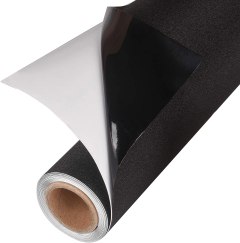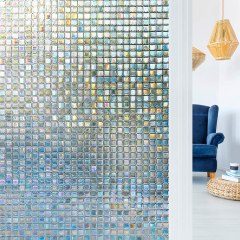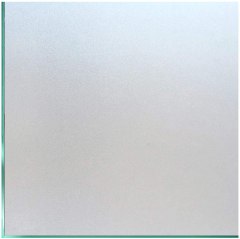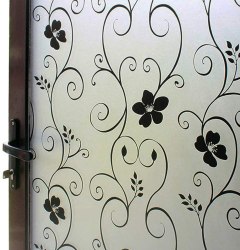BestReviews is reader-supported and may earn an affiliate commission. Details

Ideal choice for completely blacking out light. Great for night shift workers and nurseries, according to our home improvement expert.
Easy to install, non-adhesive application uses static to cling to the surface. Blackout version is great at eliminating light completely. Very thick and durable material.
Some users find it won't stay up in colder climates.

An affordable option, and raised design adds a nice texture to your glass. Earns praise from our home improvement expert for creative DIY possibilities.
Helps block out UV rays as well as conserving privacy. Easy-to-handle, residue-free static cling application. Stands out for its attractive design that's a bit different from many other options.
Users report it can curl at the corners after time.

Non-adhesive, wet application privacy product that is ideal for application in the bathroom or street-facing rooms.
This thick privacy material also aids in temperature conservation; helps insulate in the summer and preserve heat in the winter. Easy wet application. Easy to peel off and reapply.
A handful of users had trouble smoothing out bubbles during application.

A beautiful and unique privacy product in a stained glass design. Allows light in, conserves privacy, and looks great.
Stands out for its unusual and attractive floral stained glass design. Helps eliminate UV rays into your home. Wet application makes this easy to install.
Some users report imperfections in the print.

Frosted option with an attractive ornate design, adds a nice touch to any room that needs privacy.
Static cling application means no residue left on your glass. Nice ornate design adds character. Thick and durable material with easy-to-install static cling application.
Can be hard to work out bubbles during application.

We recommend these products based on an intensive research process that's designed to cut through the noise and find the top products in this space. Guided by experts, we spend hours looking into the factors that matter, to bring you these selections.

Do you have a window that you aren't quite happy with? Maybe it lets in too much sunlight or is positioned so that it presents privacy concerns. Perhaps it just looks drab, and window treatments do little to improve it. Regardless of your concern, there is an affordable way to alter the functionality and look of almost any window in your home without breaking your budget: window film.
While installing new windows can be costly, covering existing windows with window film can make changes from room-darkening effects to refreshed aesthetic appeal. You might want to reduce the visibility into your home or turn a window into a focal point with an eye-catching look.

Window film is a thin material that adheres to the smooth surface of a window to alter the appearance of the glass. Although some companies make window film from ceramic, laminate, or carbon materials, most film is made of polyester using a polyethylene terephthalate, or PET polymer. The flexible nature of the film produces a seamless fit when applied correctly, making it nearly impossible to tell that the window wasn’t custom-made to be darker or fancier than it actually is.
Applying window film has different benefits, and the film that’s best for you depends on what you want to accomplish.
Privacy: Some types of window film can make it harder for people outside to see inside.
Décor: Updating the look of a window with specialized film can take it from boring to stylish.
Darken: Some window film reduces the amount of light that enters a room.
UV protection: Some films prevent UV light from entering, which can help protect furniture, carpet, fabrics, and occupants from the damaging rays of the sun.
Depending on what you want to change about your windows, there is a type of window film available that will accomplish the look or function you desire.
Light blocking: Do you have a room that lets in too much sunlight? Window film that falls into this category is ideal for making rooms dimmer during the daytime hours. This feature is especially useful for sleeping babies and individuals who work at night and need to sleep during the day. This film is also available in different levels of darkness, with some that are opaque enough to almost completely darken a room.
Privacy: If you live on a busy street, close to other buildings, or your yard is the one where all the neighborhood kids like to gather, privacy can be a concern. Window film with a frosted, textured, or patterned finish can help correct this issue by blurring or completely obscuring the people and objects on the other side of the window. It’s perfect for ground-level rooms where privacy is especially important, such as bedrooms or bathrooms.
Decorative: This type of window film typically serves two purposes. Not only does it add an attractive design for an updated look but it also offers some degree of privacy. It’s available in a variety of styles, from artsy to floral and numerous options in between. Some decorative window film even creates the appearance of stained glass.
Window film sticks to windows either with a pre-applied adhesive or by static cling. Although the application process for both types of film is similar, there are some pros and cons to each.
Pros:
Long lasting
Durable
Tends to stay put
Cons:
Harder to apply
Imperfections hard to correct
Residue from adhesive
Difficult to remove
Pros:
Easier to apply
No residue
Easier to correct mistakes
Easy to remove
Cons:
Likelier to peel/fall off
Not as durable
Sensitive to weather, especially cold
It’s necessary to remove any dirt or residue from your windows before you apply the film. This initial step helps the film adhere to the glass.
These are for cleaning the windows. You’ll also use towels or paper towels to gently dry the windows after applying the film.
Use this to wet the windows before applying the film. This is what enables the film to stick to the glass, whether you choose film that adheres with adhesive or static cling.
You’ll need this to trim your film to the perfect size. The more accurately you cut the film, the less trimming you’ll need to do once the film is in place.
You might need a pencil to mark the film or a small section of the window frame to guide you in trimming and placing your film accurately.
You’ll need scissors to cut the film and most likely a utility knife to trim excess film after you apply it to the glass.
You’ll use a squeegee to squeeze out bubbles, lines, creases, and excess water as you put your window film in place.




















Adding film to your windows is a relatively inexpensive improvement that can easily pay for itself in enhanced comfort and style. Window film typically comes in rolls measuring approximately 17 x 80 inches that cost around $7 to $20 each.
Larger rolls of varying lengths and widths are available at a higher price. The total amount you will pay depends on the size and number of windows you wish to cover, as well as any other tools and supplies you need to purchase.

Read the instructions that come with your window film. Even if you’re pretty sure you know what you’re doing, you risk missing an important step that could affect the results if you don’t follow the application steps precisely.
Take your time. You might be excited to see the end result, but creating a seamless look that is free of bubbles and creases takes patience and a steady hand.
Gently work out bubbles. If bubbles form during the application process, gently work them to the edges of the film with a squeegee for a blemish-free finish.
Be prepared with extra supplies. If you have several windows to do, it’s a good idea to have a few extra supplies on hand. There’s a good chance you might need an additional spray bottle, squeegee, or more paper towels when tackling a big job.

A. Window film definitely has a tendency to adhere better in certain weather conditions. For example, it might dry more quickly than you can work out bubbles on a very hot day, or it might not stick at all if the weather is cold. Ideally, you’ll get the best results if you apply your film on warm, mild days when rain or humidity isn’t a factor.
A. Try using film that has a texture or pattern, which is more likely to camouflage flaws such as lines or bubbles. Although you might end up with some imperfections, chances are they’ll blend in with the lines or designs that are already part of the film.
A. While lots of types of window film will darken a room, some do a better job than others at making a room look darker in the daytime. Look for a film that indicates it is “blackout” or “light blocking” to achieve the best room-darkening results.
Get emails you’ll love.
Learn about the products you’re wondering if you should buy and get advice on using your latest purchases.
